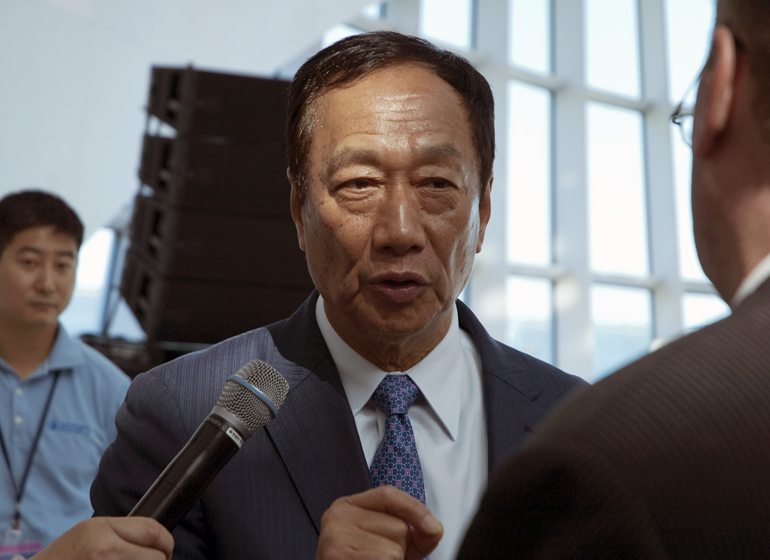Foxconn Technology Group could build up a 3,000 job cushion to help avoid potential clawbacks once minimum job requirement numbers start during the sixth year of the deal, according to a draft contract released by the Wisconsin Economic Development Corp. on Wednesday.
If Foxconn meets its ambitious hiring goals in the early years of the contract, the cushion would allow the company to potentially scale back in later years employment without having to repay tax credits. It also opens up the possibility of employment going lower than what Mark Hogan, WEDC secretary and chief executive officer, described during a press conference on Wednesday.
“Over any period of time that after this operation gets up and running, the minimum number of jobs that the company has committed to would be 6,500, which if they went below that amount would allow the state to clawback certain portions of the tax credits they have issued,” Hogan said.
In theory, employment could go as low as 5,000 starting in 2024, less than 40 percent of the company’s goal of 13,000, without triggering any jobs related repayments.
“The provision allowing Foxconn to accrue up to 3,000 jobs (1,500 per year) was put into place to give the company some additional flexibility as it begins to establish operations in Wisconsin,” WEDC said in a statement.
The WEDC board approved a staff review for the Foxconn project on Wednesday. The review is an internal WEDC document that forms the basis of the contract between Foxconn and the state. The board does not vote on the contract itself and usually does not see contracts until they are signed. The agency agreed to give board members the Foxconn contract after some lawmakers raised concerns.
Hogan said, after the vote, that part of the challenge in putting the contract together was giving the company the flexibility needed to make a large investment while also protecting taxpayers.
“The fine line was to find a way to balance the needs of the company with the needs of the state. This is a huge investment, it’s a complex deal and I think we’ve been able to do that,” he said.
Hogan also said the length of the deal added to the complexity with the company receiving up to $1.5 billion in tax credits for job creation over a 15-year period and $1.35 billion for capital investment over seven years.
Gov. Scott Walker is expected to sign the contract Friday with Foxconn chairman Terry Gou at S.C. Johnson’s facilities in Racine.
One area of concern for lawmakers during debate on the legislation passed to enable the Foxconn deal was what would happen if the deal went south. If Wisconsin had paid out millions in tax credits and Foxconn left or automated much of its work, would the state be able to get its money back? The bill said the contract would include clawbacks, but didn’t specify what they would be. That left WEDC to negotiate the specific language.
Starting in the sixth year of the contract, Foxconn has to have at least 5,850 full-time jobs in the state connected to its planned $10 billion LCD manufacturing operation to avoid having to repay previously earned tax credits. That figure jumps to 6,500, half of the projected total of 13,000, in year seven.
During the first five years of the contract, when Foxconn is expected to be constructing 20-million square feet worth of facilities, there are no minimum job levels for the company to hit to avoid clawbacks.
The contract does set up targets in years three, four and five for the company to accumulate jobs that could be applied to future years if the company falls short of the minimum clawback jobs target. Those targets are 1,300 jobs in 2020 or year three, 2,275 jobs in 2021 and 4,000 in 2022.
If Foxconn meets the minimum number of jobs required for it to actually earn job tax credits, the company would build up the maximum 3,000 job cushion allowed over the three year period. If Foxconn hits its own projections, which call for 5,200 jobs to be filled by 2020, it would build up the maximum cushion in just one year.
Foxconn is limited to using up to 1,500 jobs per year and a maximum of 3,000 during the last 10 years of the 15 year contract if it falls short of the minimum threshold to avoid clawbacks. In most years the threshold is 6,500 full-time jobs and using the cushion could prevent WEDC from declaring the company had defaulted on the contract.

If WEDC does determine Foxconn has defaulted on the contract, the company is given 30 days to fix the problem. The agency can extend that time for another 30 days, up to 180 days total. WEDC then has to provide 30 days written notice before trying to recover any tax credits, meaning roughly seven months could pass before the state is able to start getting its money back.
The clawbacks are guaranteed by a combination of Hon Hai Precision, the publically traded company behind Foxconn, Foxconn chairman Terry Gou personally, and SIO International Holdings, a privately-held company which Gou owns 89 percent of. Hon Hai is responsible for 75 percent of the clawbacks and Gou and SIO International are together responsible for the other 25 percent.
But if WEDC does seek to get any money back from Gou or Hon Hai, the credits would be paid back over the same length of time as they were awarded or eight years, whichever is shorter. The payments would be made quarterly and with a 0 percent interest rate.



